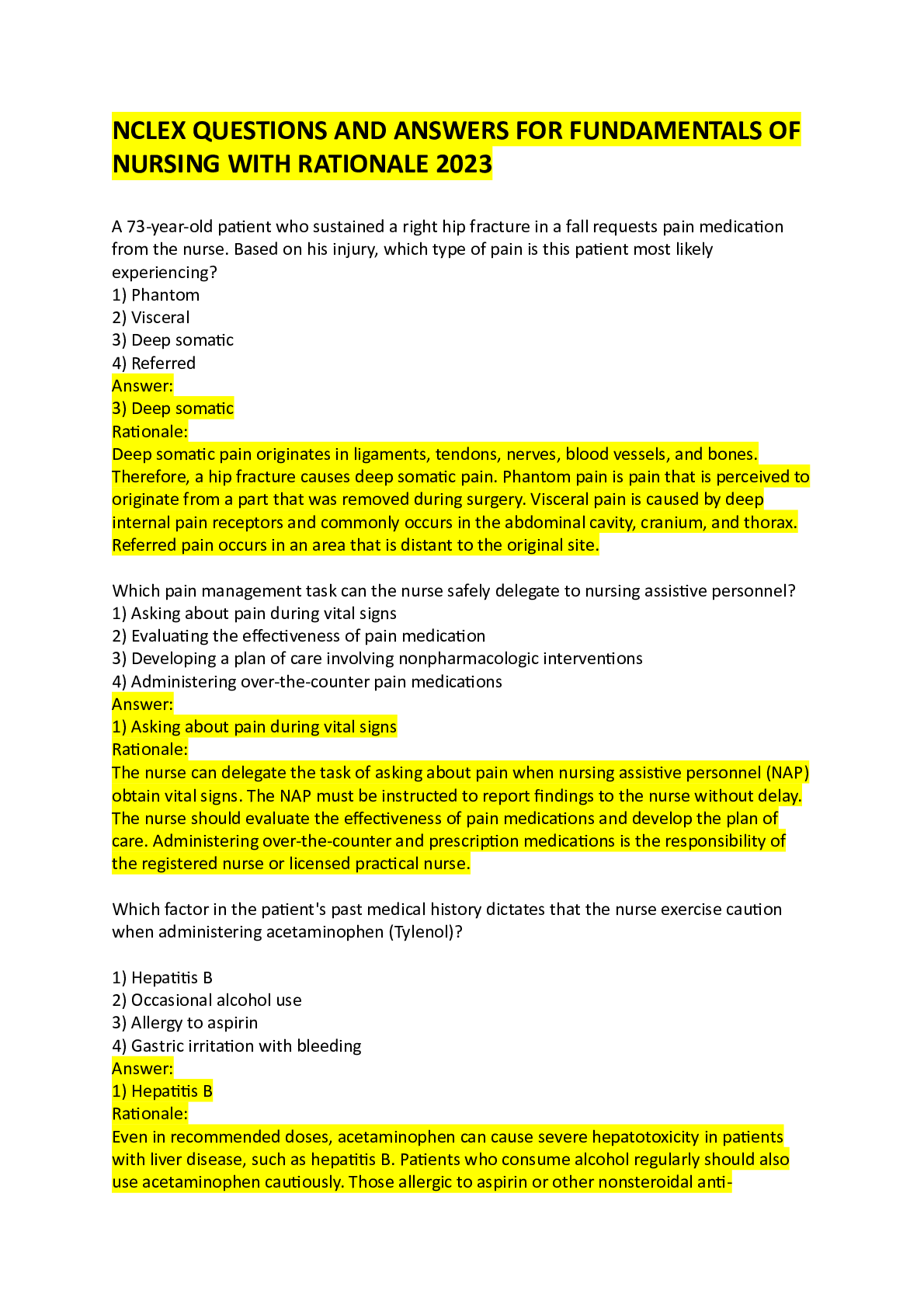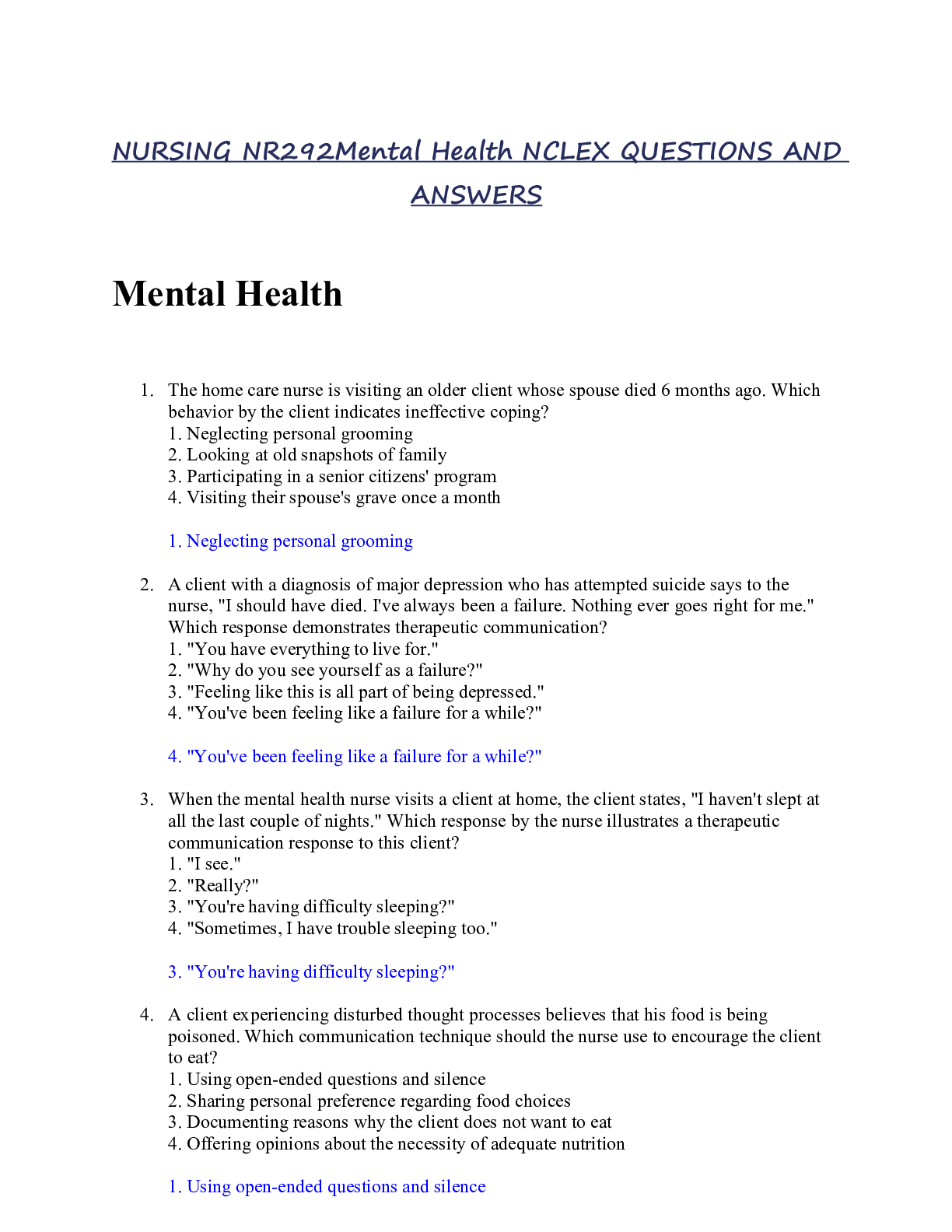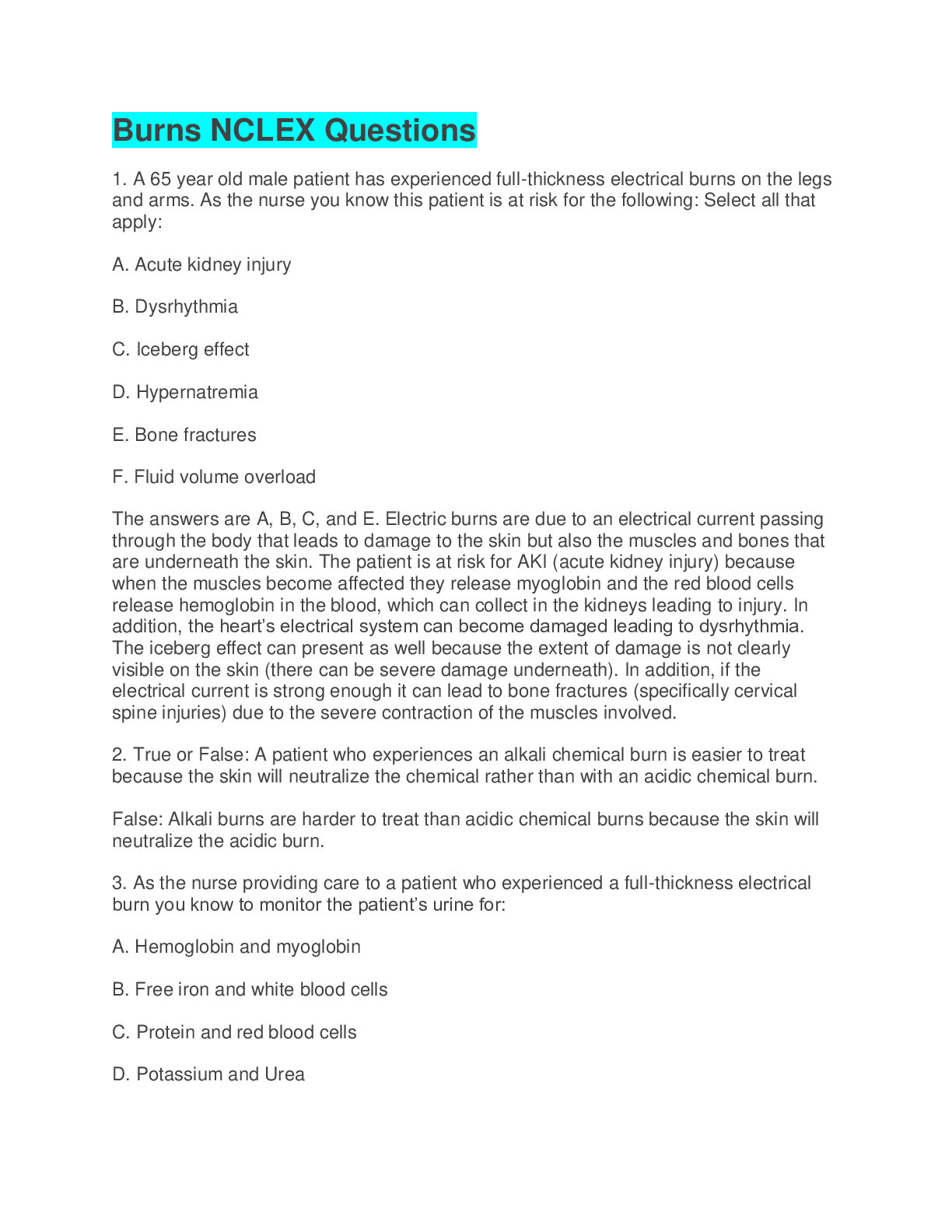MENTAL HEALTH NCLEX QUESTIONS AND ANSWERS|GRADED A+ 2022
Document Content and Description Below
Mental Health 1. The home care nurse is visiting an older client whose spouse died 6 months ago. Which behavior by the client indicates ineffective coping? 1. Neglecting personal grooming 2. Looki... ng at old snapshots of family 3. Participating in a senior citizens' program 4. Visiting their spouse's grave once a month 1. Neglecting personal grooming 2. A client with a diagnosis of major depression who has attempted suicide says to the nurse, "I should have died. I've always been a failure. Nothing ever goes right for me." Which response demonstrates therapeutic communication? 1. "You have everything to live for." 2. "Why do you see yourself as a failure?" 3. "Feeling like this is all part of being depressed." 4. "You've been feeling like a failure for a while?" 4. "You've been feeling like a failure for a while?" 3. When the mental health nurse visits a client at home, the client states, "I haven't slept at all the last couple of nights." Which response by the nurse illustrates a therapeutic communication response to this client? 1. "I see." 2. "Really?" 3. "You're having difficulty sleeping?" 4. "Sometimes, I have trouble sleeping too." 3. "You're having difficulty sleeping?" 4. A client experiencing disturbed thought processes believes that his food is being poisoned. Which communication technique should the nurse use to encourage the client to eat? 1. Using open-ended questions and silence 2. Sharing personal preference regarding food choices 3. Documenting reasons why the client does not want to eat 4. Offering opinions about the necessity of adequate nutrition 1. Using open-ended questions and silence MENTAL HEALTH NCLEX QUESTIONS AND ANSWERS/ GRADED A+ 2022 5. A client admitted to a mental health unit for treatment of psychotic behavior spends hours at the locked exit door shouting, "Let me out. There's nothing wrong with me. I don't belong here." What defense mechanism is the client implementing? 1. Denial 2. Projection 3. Regression 4. Rationalization 1. Denial 6. A client diagnosed with terminal cancer says to the nurse, "I'm going to die, and I wish my family would stop hoping for a cure! I get so angry when they carry on like this. After all, I'm the one who's dying." Which response by the nurse is therapeutic? 1. "Have you shared your feelings with your family?" 2. "I think we should talk more about your anger with your family." 3. "You're feeling angry that your family continues to hope for you to be cured?" 4. "You are probably very depressed, which is understandable with such a diagnosis." 3. "You're feeling angry that your family continues to hope for you to be cured?" 7. On review of the client's record, the nurse notes that the mental health admission was voluntary. Based on this information, the nurse anticipates which client behavior? 1. Fearfulness regarding treatment measures. 2. Anger and aggressiveness directed toward others. 3. An understanding of the pathology and symptoms of the diagnosis. 4. A willingness to participate in the planning of the care and treatment plan. 4. A willingness to participate in the planning of the care and treatment plan. 8. When reviewing the admission assessment, the nurse notes that a client was admitted to the mental health unit involuntarily. Based on this type of admission, the nurse should provide which intervention for this client? 1. Monitor closely for harm to self or others. 2. Assist in completing an application for admission. 3. Supply the client with written information about their mental illness. 4. Provide an opportunity for the family to discuss why they felt the admission was needed. 1. Monitor closely for harm to self or others. 9. The nurse is preparing a client for the termination phase of the nurse-client relationship. The nurse prepares to implement which nursing task that is most appropriate for this phase? 1. Planning short-term goals 2. Making appropriate referrals 3. Developing realistic solutions 4. Identifying expected outcomes 2. Making appropriate referrals 10. The nurse in the mental health unit recognizes which as being therapeutic communication techniques? Select all that apply. 1. Restating 2. Listening 3. Asking the client, "Why?" 4. Maintaining neutral responses 5. Providing acknowledgment and feedback 6. Giving advice and approval or disapproval o 1. Restating o 2. Listening o 4. Maintaining neutral responses o 5. Providing acknowledgment and feedback 11. A client being seen in the emergency department immediately after being sexually assaulted appears calm and controlled. The nurse analyzes this behavior as indicating which defense mechanism? 1. Denial 2. Projection 3. Rationalization 4. Intellectualization 1. Denial 12. A client's unresolved feelings related to loss would be most likely observed during which phase of the therapeutic nurse-client relationship? 1. Trusting 2. Working 3. Orientation 4. Termination 4. Termination 13. The nurse is working with a client who despite making a heroic effort was unable to rescue a neighbor trapped in a house fire. Which client-focused action should the nurse engage in during the working phase of the nurse-client relationship? 1. Exploring the client's ability to function 2. Exploring the client's potential for self-harm 3. Inquiring about the client's perception or appraisal of why the rescue was unsuccessful 4. Inquiring about and examining the client's feelings for any that may block adaptive coping 4. Inquiring about and examining the client's feelings for any that may block adaptive coping 14. The nurse employed in a mental health unit of a hospital is the leader of a group psychotherapy session. What is the nurse's role during the termination stage of group development? 1. Acknowledging that the group has identified goals 2. Encouraging the accomplishment of the group's work 3. Acknowledging the contributions of each group member 4. Encouraging members to become acquainted with one another 3. Acknowledging the contributions of each group member 15. Which are characteristics of the termination stage of group development? Select all that apply. 1. The group evaluates the experience. 2. The real work of the group is accomplished. 3. Group interaction involves superficial conversation. 4. Group members become acquainted with each other. 5. Some structuring of group norms, roles, and responsibilities takes place. 6. The group explores members' feelings about the group and the impending separation. o 1. The group evaluates the experience. o 6. The group explores members' feelings about the group and the impending separation. 16. When a client is admitted to an inpatient mental health unit with the diagnosis of anorexia nervosa, a cognitive behavioral approach is used as part of the treatment plan. The nurse understands that which is the purpose of this approach? 1. Providing a supportive environment 2. Examining intrapsychic conflicts and past issues 3. Emphasizing social interaction with clients who withdraw 4. Helping the client to examine dysfunctional thoughts and beliefs 4. Helping the client to examine dysfunctional thoughts and beliefs 17. The nurse understands that which best describes Gestalt therapy? 1. It emphasizes self-expression, self-exploration, and self-awareness in the present. 2. It promotes the individual's comfort in the group, which then transfers to other relationships. 3. The therapist focuses on how irrational beliefs and thoughts contribute to psychological distress. 4. The therapist's goal is to help others express their feelings toward one another during group sessions. 1. It emphasizes self-expression, self-exploration, and self-awareness in the present. 18. A client is preparing to attend a Gamblers Anonymous meeting for the first time. The nurse should tell the client that which is the first step in this 12-step program? 1. Admitting to having a problem 2. Substituting other activities for gambling 3. Stating that the gambling will be stopped 4. Discontinuing relationships with people who gamble 1. Admitting to having a problem 19. Which describes the primary focus of milieu therapy? 1. A form of behavior modification therapy 2. A cognitive approach to changing behavior 3. A living, learning, or working environment 4. A behavioral approach to changing behavior 3. A living, learning, or working environment 20. While being treated, a client is introduced to short periods of exposure to the phobic object while in a relaxed state. What term is used to describe this form of behavior modification? 1. Milieu therapy 2. Aversion therapy 3. Self-control therapy 4. Systematic desensitization 4. Systematic desensitization 21. A client is planning to attend Overeaters Anonymous. Which statement by the client indicates a need for additional information regarding this self-help group? 1. "The leader is a nurse or psychiatrist." 2. "The members provide support to each other." 3. "People who have a similar problem are able to help others." 4. "It is designed to serve people who have a common problem." 1. "The leader is a nurse or psychiatrist." 22. What is the most appropriate nursing action to help manage a manic client who is monopolizing a group therapy session? 1. Ask the client to leave the group for this session only. 2. Refer the client to another group that includes other manic clients. 3. Tell the client to stop monopolizing in a firm but compassionate manner. 4. Thank the client for the input, but inform the client that now others need a chance to contribute. 4. Thank the client for the input, but inform the client that now others need a chance to contribute. 23. Which type of therapeutic approach has the characteristic that all team members are seen as equally important in helping clients meet their goals? 1. Milieu therapy 2. Interpersonal therapy 3. Behavior modification 4. Rational emotive therapy 1. Milieu therapy 24. A client says to the nurse, "The federal guards were sent to kill me." What is the best nursing response to the client's concern? 1. "I don't believe this is true." 2. "The guards are not out to kill you." 3. "Do you feel afraid that people are trying to hurt you?" 4. "What makes you think the guards were sent to hurt you?" 3. "Do you feel afraid that people are trying to hurt you?" 25. A client diagnosed with delirium becomes disoriented and confused at night. Which intervention should the nurse implement initially? 1. Move the client next to the nurse's station. 2. Use an indirect light source and turn off the television. 3. Keep the television and a soft light on during the night. 4. Play soft music during the night, and maintain a well-lit room. 2. Use an indirect light source and turn off the television. 26. A client is admitted to the mental health unit with a diagnosis of depression. The nurse should develop a plan of care for the client that includes which intervention? 1. Encouraging quiet reading and writing for the first few days 2. Identification of physical activities that will provide exercise 3. No socializing activities, until the client asks to participate in milieu 4. A structured program of activities in which the client can participate 4. A structured program of activities in which the client can participate 27. When planning the discharge of a client with chronic anxiety, the nurse directs the goals at promoting a safe environment at home. Which is the most appropriate maintenance goal? 1. Suppressing feelings of anxiety 2. Identifying anxiety-producing situations 3. Continued contact with a crisis counselor 4. Eliminating all anxiety from daily situations 2. Identifying anxiety-producing situations 28. A client is unwilling to go out of the house for fear of "making a fool of myself in public." Because of this fear, the client remains homebound. Based on these data, which mental health disorder is the client experiencing? 1. Agoraphobia 2. Social phobia 3. Claustrophobia 4. Hypochondriasis 2. Social phobia 29. The nurse is conducting a group therapy session. During the session, a client diagnosed with mania consistently disrupts the group's interactions. Which intervention should the nurse initially implement? 1. Setting limits on the client's behavior 2. Asking the client to leave the group session 3. Asking another nurse to escort the client out of the group session 4. Telling the client that they will not be able to attend any future group sessions 1. Setting limits on the client's behavior 30. A client is admitted to a medical nursing unit with a diagnosis of acute blindness after being involved in a hit-and-run accident. When diagnostic testing cannot identify any organic reason why this client cannot see, a mental health consult is prescribed. Which condition will be the focus of this consult? 1. Psychosis 2. Repression 3. Conversion disorder 4. Dissociative disorder 3. Conversion disorder 31. A manic client begins to make sexual advance towards visitors in the dayroom. When the nurse firmly states that this is inappropriate and will not be allowed, the client becomes verbally abusive and threatens physical violence to the nurse. Based on the analysis of this situation, which intervention should the nurse implement? 1. Place the client in seclusion for 30 minutes. 2. Tell the client that the behavior is inappropriate. 3. Escort the client to their room, with the assistance of other staff. 4. Tell the client that their telephone privileges are revoked for 24 hours. 3. Escort the client to their room, with the assistance of other staff. 32. Which nursing interventions are appropriate for a hospitalized client with mania who is exhibiting manipulative behavior? Select all that apply. 1. Communicate expected behaviors to the client. 2. Ensure that the client knows that they are not in charge of the nursing unit. 3. Assist the client in identifying ways of setting limits on personal behaviors. 4. Follow through about the consequences of behavior in a nonpunitive manner. 5. Enforce rules by informing the client that they will not be allowed to attend therapy groups. 6. Have the client state the consequences for behaving in ways that are viewed as unacceptable. o 1. Communicate expected behaviors to the client. o 3. Assist the client in identifying ways of setting limits on personal behaviors. o 4. Follow through about the consequences of behavior in a nonpunitive manner. o 6. Have the client state the consequences for behaving in ways that are viewed as unacceptable. 33. The nurse observes that a client is pacing, agitated, and presenting aggressive gestures. The client's speech pattern is rapid, and affect is belligerent. Based on these observations, what is the nurse's immediate priority of care? 1. Provide safety for the client and other clients on the unit. 2. Provide the clients on the unit with a sense of comfort and safety. 3. Assist the staff in caring for the client in a controlled environment. 4. Offer the client a less stimulating area to calm down in and gain control. 1. Provide safety for the client and other clients on the unit. 34. The nurse is preparing a client with a history of command hallucinations for discharge by providing instructions on interventions for managing hallucinations and anxiety. Which statement in response to these instructions suggests to the nurse that the client understands the instructions? 1. "My medications aren't likely to make me anxious." 2. "I'll go to support group and talk so that I don't hurt anyone." 3. "It's not likely that I'll get anxious or hear things if I get enough sleep and eat well." 4. "When I begin to hallucinate, I'll call my therapist and talk about what I should do." 4. "When I begin to hallucinate, I'll call my therapist and talk about what I should do." 35. The nurse is caring for a client diagnosed with catatonic stupor who is lying on the bed in a fetal position. What is the most appropriate nursing intervention? 1. Ask direct questions to encourage talking [Show More]
Last updated: 2 years ago
Preview 1 out of 70 pages
 (1).png)
Buy this document to get the full access instantly
Instant Download Access after purchase
Buy NowInstant download
We Accept:

Reviews( 0 )
$15.00
Can't find what you want? Try our AI powered Search
Document information
Connected school, study & course
About the document
Uploaded On
May 14, 2022
Number of pages
70
Written in
Additional information
This document has been written for:
Uploaded
May 14, 2022
Downloads
0
Views
205

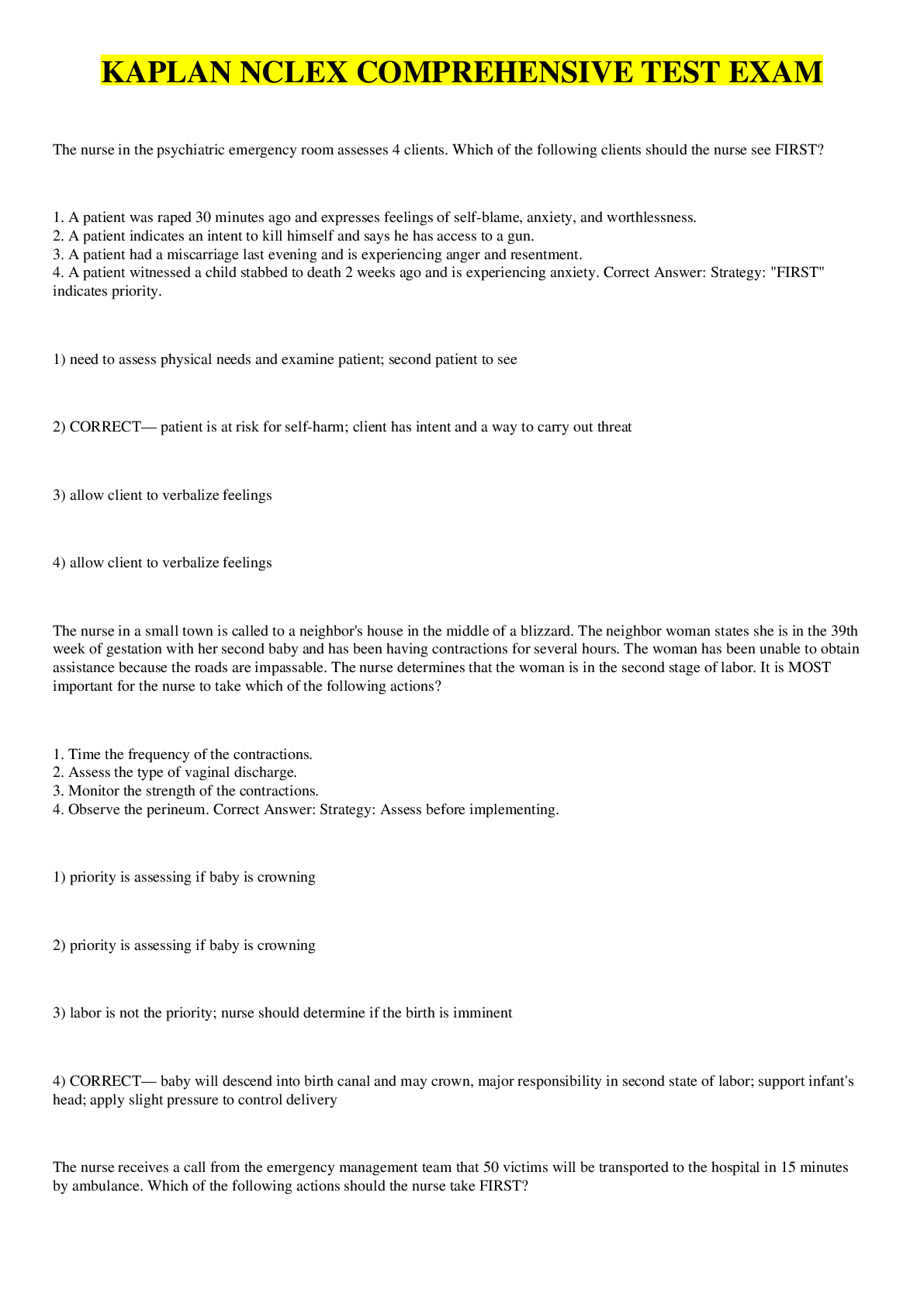
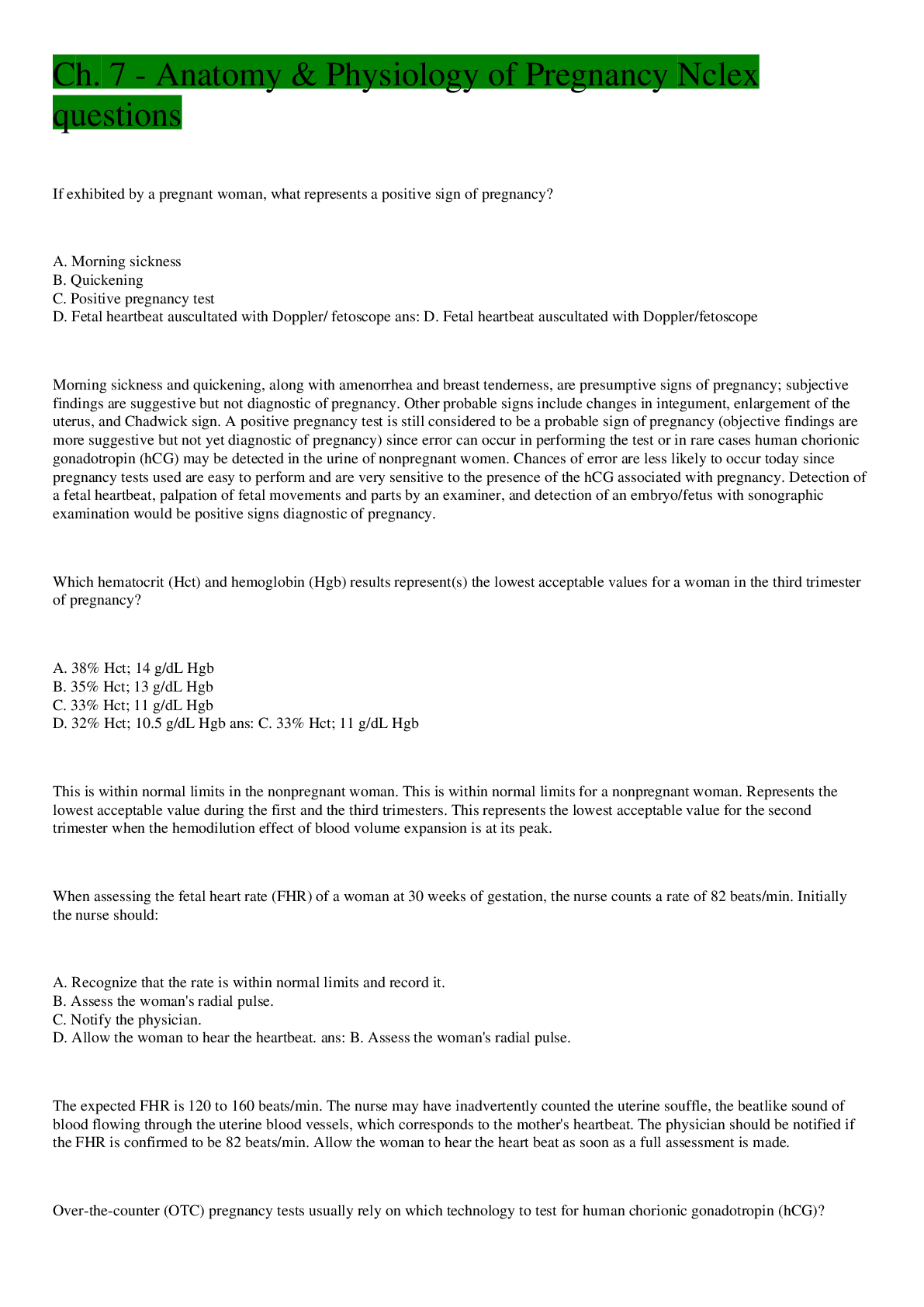
 Third Editions.png)
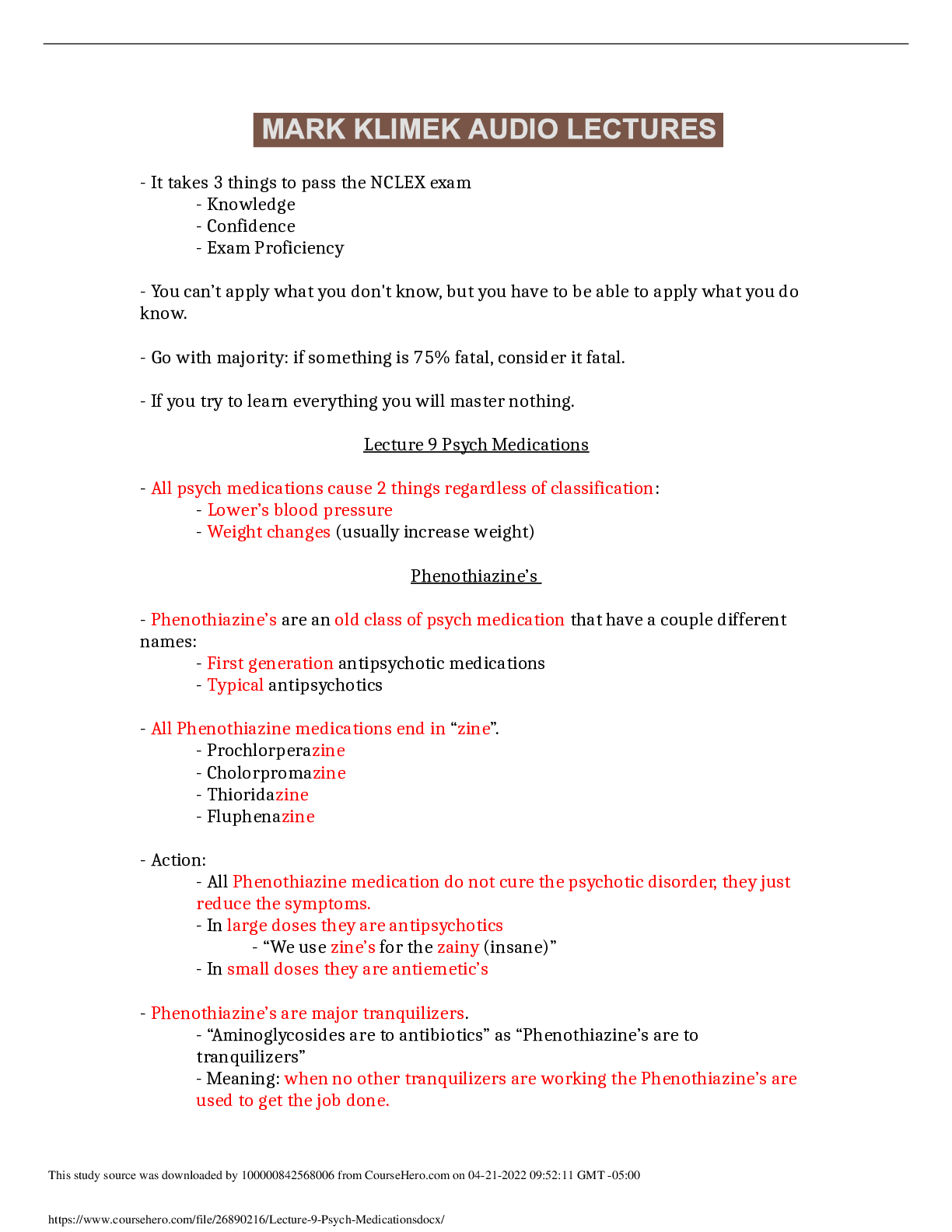
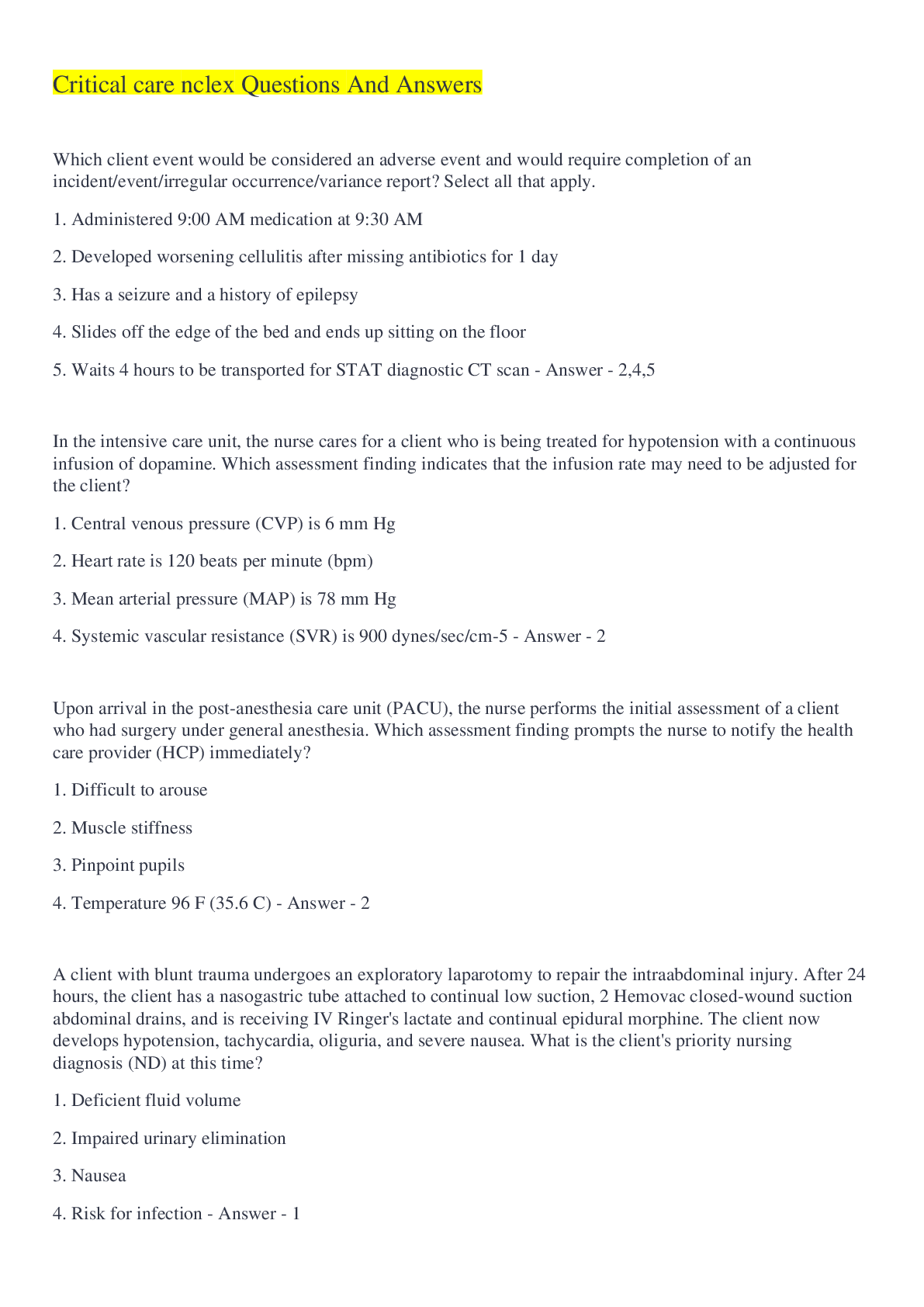

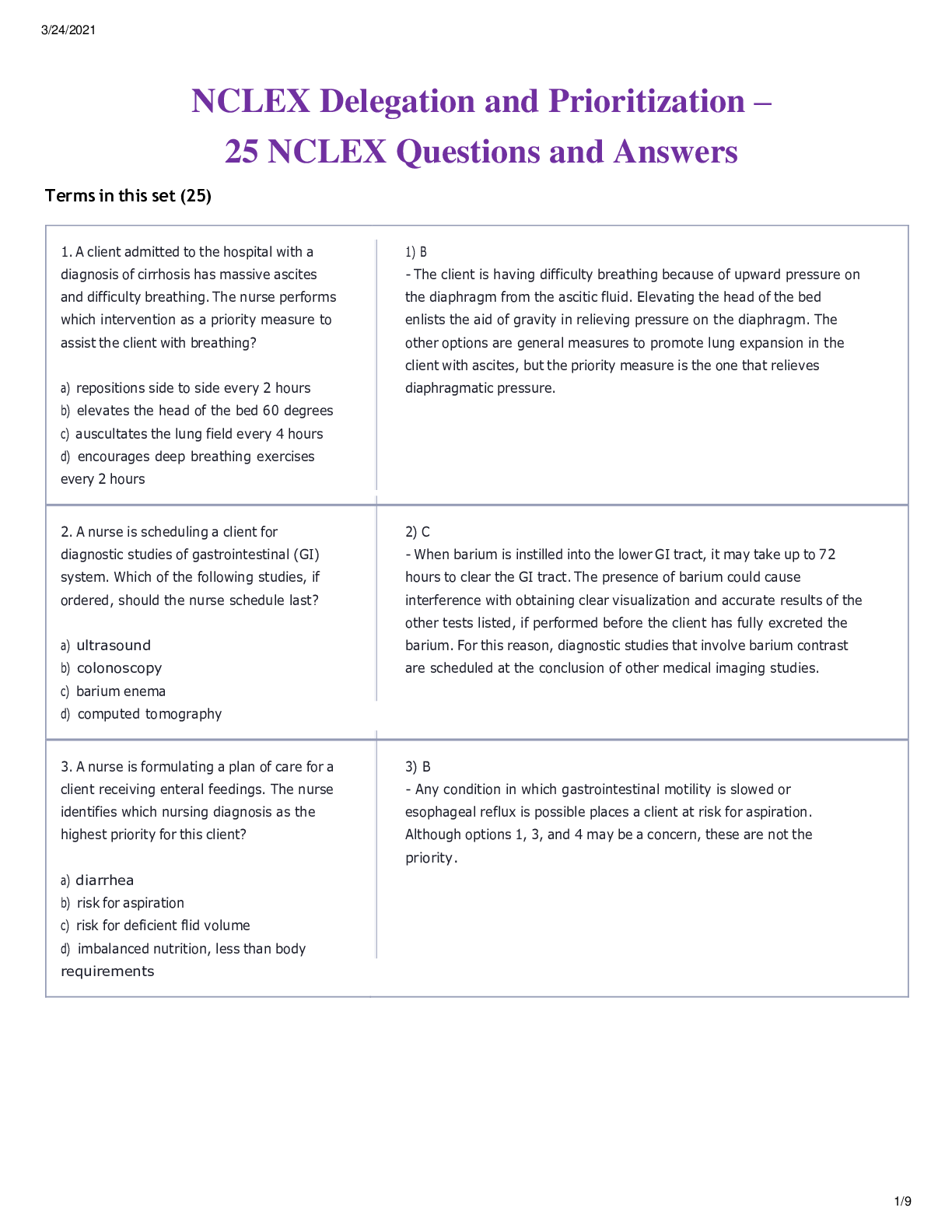




 (1).png)

